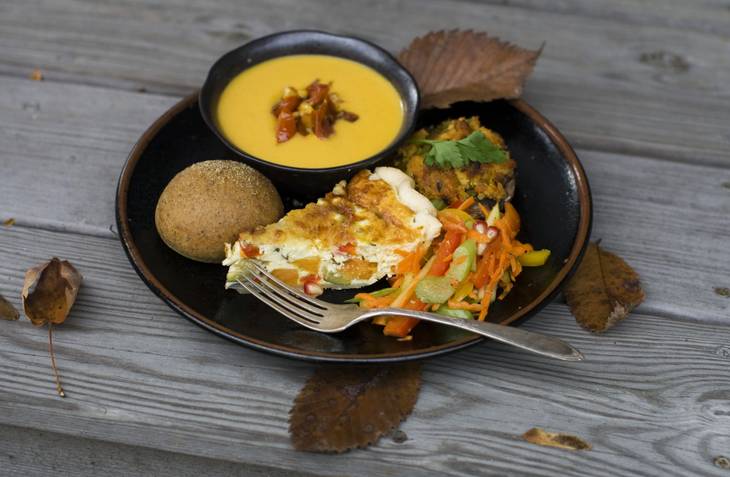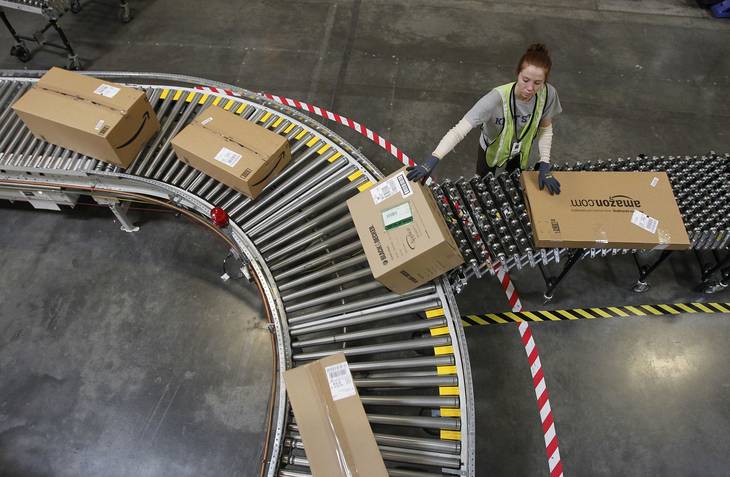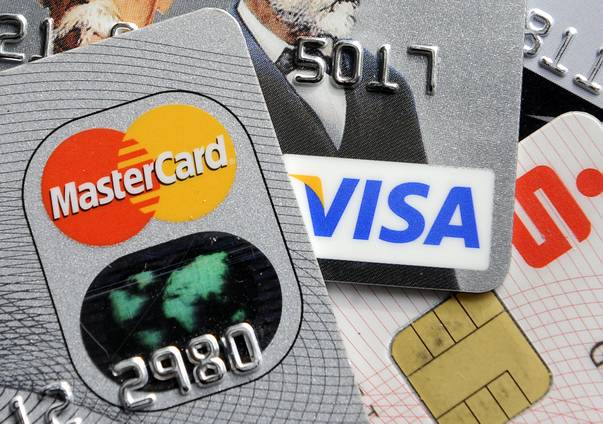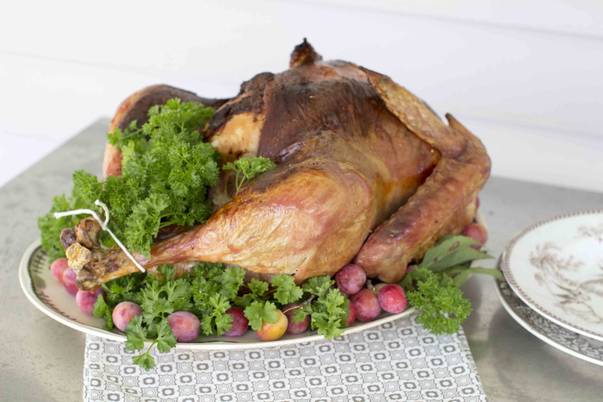The holidays are notoriously stressful. But they don't have to be.
We've compiled three guides to improve the chances you won't pull your hair out: how to prepare for the holidays before they happen, how to snag killer Black Friday deals and how to cook the perfect turkey.
Prepare ahead of time
-

Ready or not, here they come — the holidays.
This year, save yourself a little time and a lot of stress by starting early. Like now. You’ll be happy you did. Then you can spend the holidays celebrating what really matters: family, friends and traditions that make the season sparkle.
Here are a few tips on tasks you can do well before the official countdown begins.
Mark your calendar
Block out dates on which you know you’ll be busy with work and family parties, children’s outings, school concerts, baking and, of course, shopping.
-

Stephanie Deppensmith, her husband Alex Karvounis and daughter Harper Karvounis, 22 months, go grocery shopping at Walmart Sunday, Jan. 22, 2012.
Book your sitters
Once you know your dates, call and book your babysitter stat. The holidays book up for everybody, sitters included, so call dibs on him or her ASAP.
Plan your menus
Throwing a party? Or two? Or three? Nothing is stopping you from planning your menu now.
Shop for staples
Make a list of the ingredients and supplies you’ll need for entertaining, baking and gift-giving. Then add a few of the items to your shopping list every time you head to the store over the next few weeks. Buy nonperishable items that are easy to store and will come in handy when your head is dancing with sugarplums. Suggestions: paper products (plates, cups, utensils, napkins); pumpkin pie filling; frozen pie crusts; butter; breadcrumbs; cooking stock; beer, wine, soda; cocktail mixers; and baking staples (sugar, flour, chocolate chips, decorations).
-

Gift boxes during the Luxe Party at the Kendra Scott Fashion Island Boutique on Tuesday, November 20, 2013, in Newport Beach, Calif.
Set up a wrapping station
Space is at a premium in most people’s homes, but if you can find a flat surface that can remain mostly open for the next month or so, it will make your life easier in the long run. Keep wrapping paper, tape, scissors, tags and a pen nearby, and you can chip away at your mountain of wrapping little by little. Such a nook also comes in handy for emergency wrap jobs.
Stock up on “everybody/anytime” gifts
Buy 10 of something — particularly if you find a great deal. Yes, 10! Candles, boxes of candy, fancy soap, iTunes cards, car wash gift certificates, ornaments, cozy holiday throws, kitchen towel sets, you name it. Wrap each one with a tag, and throw them in a bag. Your “everybody/anytime” stash will come in handy when a friend drops by with “a little something” or your child reminds you that she has TWO teachers this year.
Prepare address labels
When it comes to writing holiday cards, consider: Personal messages — yes; addresses — forget it. Start a digital database, and invest in sticky labels. Start compiling or updating addresses now. You’ll save tons of time when you’re ready to write the cards. Peel and stick, baby!
-

Shop and ship in advance
Have friends or family out of town? Consider shopping, wrapping and shipping gifts far in advance. Get those folks out of the way first, and you won’t spend so much time waiting in line at the post office. Just be sure to include critical “don’t open until …” instructions.
Shop year-round
If you haven’t started shopping for everyone on your list already, start now. Consider placing bags or boxes labeled with your loved ones’ names in a closet or garage. When you see something they might like, pick it up, throw it in the bag, and hold onto it until you’re ready to wrap. Next thing you know, your shopping is done!
How to win Black Friday
-
The busiest shopping day of the year is nearly upon us. How will you spend Black Friday?
1. Shopping til you drop.
2. Avoiding malls at all costs.
3. You’re not sure.
• Do research: Check circulars and store websites ahead of time to see what deals will be offered. Be sure to read the fine print; some deals are valid only during certain times. Also, price shop online to make sure Black Friday offers really are good buys.
• Team up: Join forces with family and friends to divide and conquer stores. Even the most veteran shoppers should plan on hitting a maximum of four shops. Most good deals end by noon, and prime merchandise goes quickly.
• Do recon: Visit stores before Black Friday to get a lay of the land and talk to employees. Find out where workers plan to display the items you want.
• Make a plan: List, by store, the items you want to buy. Decide which stores you want to visit first, and map your route.
How to avoid stress
• Bring snacks to keep you energized — bananas, apples, nuts or graham crackers, for example. You won’t have to waste time stopping for food, and you’ll keep up your energy.
• Dress comfortably. Layers are key for two reasons: One, you’ll likely get hot, and two, you can try clothes on over your bottom layer and avoid jam-packed dressing rooms.
• Leave the kids at home. The only thing more stressful than trying to beat 35 people to the last “Frozen” Olaf is doing it with children on your arm. And navigating a stroller through crowds can be dicey. If you have to bring along your children, designate a meeting spot in case you get separated.
• Get dropped off so you won’t have to battle busy parking lots. Choose a meeting spot away from the front entrance and crowds.
Check out these websites
• Theblackfriday.com: A clearinghouse of Black Friday ads.
• Pricegrabber.com: A price tracker that lists the lowest and average daily prices for items online and in stores.
• Camelcamelcamel.com: Provides highest, lowest and average online price histories for thousands of items.
• Retailmenot.com: Tons of in-store and online coupons.
• Keep.google.com: A great way to make and organize multiple lists.
-
Or ... buy nothing
While the masses camp out in front of big-box stores on Black Friday and line up at cash registers, a growing number of people are choosing to buy nothing to make a statement.
The Buy Nothing movement, which aims to take back Christmas from commercial forces, claims millions of devotees in more than 65 countries.
Founded in the ’90s by a Vancouver artist, the protest goes beyond keeping wallets closed. Organizers also suggest protests to point out people’s consumerism. There are credit card cut-ups, where supporters stand in a mall with signs and scissors offering to slash people’s plastic; zombie walks, in which clans of costumed folks wander around shopping centers staring blankly ahead to mimic the “comatose expressions on the faces of shoppers;” and Whirl-Marts, where 10 friends silently drive shopping carts around stores without buying anything.
Organizers say the success of the movement gives them hope that humanity hasn’t been completely lost to consumerism. It’s also a case study in the power of the Internet as a political organizing tool. The Buy Nothing movement started at adbusters.org.
And — no surprise — advertisers and retailers hate it. In the movement’s early days, organizers tried to buy television airtime to spread their message, but every major network declined to run their commercial.
What to do instead of shop
• Go out to eat. Most restaurants will be surprisingly empty because so many people are shopping. Just avoid shopping center eateries; parking will be insane.
• Have a movie marathon. Snuggle up on the couch and watch holiday movies.
• Throw a “Free from Black Friday” party. Invite friends and family over for food, drinks and company. Added bonus: This is a great way to get rid of Thanksgiving leftovers.
• Visit a museum. Most are open on Black Friday and free of crowds.
• Volunteer. Celebrate what you have to be thankful for by helping others.
Cook the perfect turkey
-
For most of us (sorry, vegetarians!), turkey is the centerpiece of Thanksgiving. But cooking the perfect bird can be challenging at best.
Potential pitfalls are well documented: The turkey still is frozen after hours in the oven; it’s undercooked or overcooked or dried out beyond oblivion.
Don’t be intimidated. Even novice chefs can make a masterful turkey with the right tips.
When buying
Size: For smaller birds that weigh 12 pounds or less, plan on serving 2 pounds per person. For bigger birds weighing 15 to 20 pounds, figure on 1 1/2 pounds per person. Why the difference? Smaller birds have a lower meat-to-bone ratio.
Type: Frozen turkeys typically are cheaper, but freezing can dry out the meat. Fresh, air-chilled birds are juicier and more flavorful; you can buy those at specialty grocery stores or butchers. Avoid salt-injected turkeys that are pumped with artificial flavoring as the additives tend to dry the meat and overpower the natural turkey taste.
Pan: A heavy stainless steel pan is your best bet; they heat up evenly and are more durable than aluminum. Use a rectangular pan with sides about 3 inches tall, just big enough to fit your turkey, breast side up. Don’t forget to buy a rack if your pan doesn’t come with one. Also, avoid nonstick pans as they will prevent your food from browning and caramelizing.
When preparing
Thaw: Thaw your turkey in the refrigerator, breast side up, in an unopened wrapper on a rimmed baking sheet. Place it on the bottom row to avoid drips. Allow a full day of thawing for every 4 pounds. For crispier skin, unwrap the turkey the night before cooking and let it chill uncovered overnight. For a faster thaw, fill a large tub with cold water and dunk the wrapped bird. It will take about 30 minutes per pound to thaw. Change the water every 30 minutes to keep the bird cold and prevent bacteria from growing. Avoid using warm or hot water, which will start cooking the turkey.
Clean: Make sure to remove the giblets, usually stored in a packet in the neck area of the bird. Drain the turkey of any juices and blot it dry, inside and out, with paper towels. Tuck the wings to help stabilize the bird.
Ice: Dark meat takes longer to cook than white meat. To prevent white meat from overcooking, chill the turkey breasts with ice packs before roasting. Drape gallon-size plastic bags filled with ice over the top of the turkey to cover the breasts. Leave on for about 30 minutes, then remove and place the turkey immediately in the oven. The resulting temperature differential will allow the legs and breasts to reach their ideal temperatures at the same time.
-
When cooking
Dress: Consider skipping the stuffing. A turkey won’t cook properly if it is stuffed densely. Instead, fill the cavity with carrots, celery, onion, lemon, garlic and herbs, and cook the stuffing in a casserole dish on the side. If you do choose to stuff, make sure to do it immediately before cooking. Stuffing the bird the night before can enable bacteria to grow.
Coat: Before roasting, coat the turkey with vegetable or olive oil. The oil will make the skin brown and crispy.
Season: Skip the salt and brine, which can over-season the bird and dry it out. Instead, use a flavorful herb rub of rosemary, oregano or parsley.
Cover: Tightly cover the breast with aluminum foil to prevent burning. Remove the foil from the breast about 45 minutes before your turkey is finished cooking to allow the skin to brown.
Roast: Cooking times differ depending on whether the bird was fresh or frozen. In a 325 degree oven, allow about 25 minutes per pound for a defrosted turkey and about 15 minutes per pound for a fresh one. Make sure to preheat your oven and place the baking rack at its lowest setting to prevent burning and dryness.
Test: Use an oven thermometer to ensure a proper roasting temperature. Don’t trust the pop-up thermometers that come in some turkeys. Place your own thermometer in the deepest part of the turkey’s thigh, careful not to touch the bone, and remove the turkey from the oven when the temperature hits 175 degrees. The breast should measure 160 degrees, and the juices should run clear. The turkey will continue cooking, so make sure not to let the thigh temperature reach 180 degrees. If you stuffed the bird, make sure the internal temperature of the stuffing is at least 165 degrees.
No peeking: When oven temperature fluctuates, as happens when the oven door is opened, the turkey cooks unevenly and tends to dry out. So avoid basting and resist the urge to peek.
When serving
Let it rest: Let your turkey sit for at least 25 minutes after cooking to allow the meat to absorb the cooking juices. If you carve it too soon, the juices will run out, and you’ll be left with a dry bird. Also, don’t cover the turkey. A wrap will cause the skin to steam and will turn crispy skin soggy.
Use the right tools: To slice the bird, you’ll need a very sharp chef’s knife or carving knife, and a carving fork. The longer the knife, the better, for easy slicing deep into the breast.
The right cut: Slice pieces at least half an inch thick to keep the moisture in. Cut against the grain of the meat to preserve tenderness. Most experts recommend carving in the kitchen rather than at the table to prevent a mess — and unsolicited advice.
*******
* Toms are male turkeys, hens are females. Toms grow at a faster rate than hens and can weigh more than 30 pounds. Hens typically tip the scale at about 12 to 14 pounds.
* Skinless white turkey meat has only about 100 calories in a 3-ounce serving. Skin adds about 60 calories and a large amount of sodium but is full of healthy monosaturated fat.








